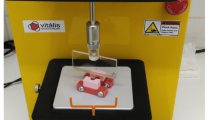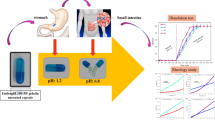Abstract
Purpose
To investigate the compatibility between hard gelatin and HPMC capsules with a range of different isotropic lipid based formulations containing multiple excipients.
Methods
The miscibility was investigated for 350 systems applying five different oils (Labrafac ™ lipophile WL1349, Maisine® CC, Captex 300 EP/NF, olive oil, and Capmul MCM EP/NF), five different surfactans (Labrasol ® ALF, Labrafil M 2125 CS, Kolliphor ® ELP, Kolliphor ® HS 15, Tween 80) and three different cosolvents (propylene glycol, polyethylene glycol 400, and Transcutol ® HP). For the isotropic systems capsule compatibility was investigated in both gelatin and HPMC capsules at 25°C at 40% and 60% relative humidity by examining physical damages to the capsules and weight changes after storage.
Results
The miscibility of lipid based vehicles was best when the formulation contained monoglycerides and surfactants with a hydrophilic–lipophilic balance value <12. Gelatin capsules in general resulted in a better compatibility when compared to HPMC capsules for the evaluated formulations. Addition of water to the formulation improved the capsule compatibility for both capsule types. The expected capsule mass change could partly be predicted in binary systems using the provided data of the single excipients weighted for its formulation proportion.
Conclusions
The capsule compatibility was driven by the components incorporated into the formulations, where more was compatible with gelatin than HPMC capsules. Prediction of the mass change from individual excipient contributions can provide a good first estimate if a vehicle is compatible with a capsule, however, this needs to be proved experimentally.






Similar content being viewed by others
References
Ditzinger F, Price DJ, Ilie AR, Köhl NJ, Jankovic S, Tsakiridou G, et al. Lipophilicity and hydrophobicity considerations in bio-enabling oral formulations approaches - a PEARRL review. J Pharm Pharmacol. 2019;71:464–82.
Pouton CW. Formulation of poorly water-soluble drugs for oral administration: physicochemical and physiological issues and the lipid formulation classification system. Eur J Pharm Sci. 2006;29:278–87.
Jannin V, Musakhanian J, Marchaud D. Approaches for the development of solid and semi-solid lipid-based formulations. Adv Drug Deliv Rev. 2008;60:734–46.
Gullapalli RP, Mazzitelli CL. Gelatin and non-gelatin capsule dosage forms. J Pharm Sci. 2017;106:1453–65.
Savla R, Browne J, Plassat V, Wasan KM, Wasan EK. Review and analysis of FDA approved drugs using lipid-based formulations. Drug Dev Ind Pharm. 2017;43:1743–58.
Cole ET. Liquid filled and sealed hard gelatin capsules. Bull Tech Gattefossé. 1999;92:67–77.
Cole ET, Cadé D, Benameur H. Challenges and opportunities in the encapsulation of liquid and semi-solid formulations into capsules for oral administration. Adv Drug Deliv Rev. 2008;60:747–56.
Reich G. Formulation and physical properties of soft capsules. In: Podczeck F, Jones BE, editors. Pharmaceutical Capsules. London: Pharmaceutical Press; 2004. p. 201–12.
Machado AH, Kokubo T, Dujovny G, Jones B, Scialdone C, Bravo R, et al. A microstructural study of water effects in lipid-based pharmaceutical formulations for liquid filling of capsules. Eur J Pharm Sci. 2016;90:64–75.
Chen FJ, Etzler FM, Ubben J, Birch A, Zhong L, Schwabe R, et al. Effects of lipophilic components on the compatibility of lipid-based formulations with hard gelatin capsules. J Pharm Sci. 2010;99:128–41.
Kesisoglou F, Panmai S, Wu Y. Nanosizing--oral formulation development and biopharmaceutical evaluation. Adv Drug Deliv Rev. 2007;59:631–44.
Djekic L, Jankovic J, Čalija B, Primorac M. Development of semisolid self-microemulsifying drug delivery systems (SMEDDSs) filled in hard capsules for oral delivery of aciclovir. Int J Pharm. 2017;528:372–80.
Digenis GA, Gold TB, Shah VP. Cross-linking of gelatin capsules and its relevance to their in vitro-in vivo performance. J Pharm Sci. 1994;83:915–21.
Brown J, Madit N, Cole ET, Wilding IR, Cadé D. The effect of cross-linking on the in vivo disintegration of hard gelatin capsules. Pharm Res. 1998;15:1026–30.
Kontny MJ, Mulski CA. Gelatin capsule brittleness as a function of relative humidity at room temperature. Int J Pharm. 1989;54:79–85.
Liebowitz SM, Vadino WA, Ambrosio TJ. Determination of hard gelatin capsule brittlenss using a motorized compression test stand. Drug Dev Ind Pharm. 1990;16:995–1010.
Kuentz M. Oral self-emulsifying drug delivery systems, from biopharmaceutical to technical formulation aspects. J Drug Del Sci Tech. 2011;21:17–26.
Honkanen O, Laaksonen P, Marvola J, Eerikäinen S, Tuominen R, Marvola M. Bioavailability and in vitro oesophageal sticking tendency of hydroxypropyl methylcellulose capsule formulations and corresponding gelatine capsule formulations. Eur J Pharm Sci. 2002;15:479–88. Erratum in: Eur J Pharm Sci 2002;17:105.
Ku MS, Lu Q, Li W, Chen Y. Performance qualification of a new hypromellose capsule: part II. Disintegration and dissolution comparison between two types of hypromellose capsules. Int J Pharm. 2011;416:16–24.
Grüne L, Bunjes H. Suitability of phosphatidylcholine-based formulations for liquid filling in hard capsules. Eur J Pharm Sci. 2020;153:105470.
https://www.gattefosse.com/pharmaceuticals-products/labrafac-lipophile-wl-1349/, Accessed 14 May 2021.
https://www.gattefosse.com/pharmaceuticals-products/maisine-cc/, Accessed 14 May 2021.
https://www.gattefosse.com/pharmaceuticals-products/labrasol-alf/, Accessed 14 May 2021.
https://www.gattefosse.com/pharmaceuticals-products/labrafil-m-2125-cs/, Accessed 14 May 2021.
https://www.sigmaaldrich.com/content/dam/sigma-aldrich/docs/Sigma-Aldrich/Product_Information_Sheet/p8074pis.pdf, Accessed 14 May 2021.
Kuentz M, Röthlisberger D. Determination of the optimal amount of water in liquid-fill masses for hard gelatin capsules by means of texture analysis and experimental design. Int J Pharm. 2002;236:145–52.
Cadé D, Madit N. Liquid filling in hard gelatin capsules - preliminary steps. Capsugel 1996.
Reichert CL, Salminen H, Leuenberger BH, Weiss J. Influence of heat on miscibility of Quillaja saponins in mixtures with a co-surfactant. Food Res Int. 2016;88:16–23.
Damian F, Harati M, Schwartzenhauer J, Van Cauwenberghe O, Wettig SD. Challenges of dissolution methods development for soft gelatin capsules. Pharmaceutics. 2021;13:214.
https://www.capsugel.com/knowledge-center/vcapsplus-faq-moisture-and-storage-conditions#:~:text=Recommended%20storage%20conditions%20for%20both%20gelatin%20and%20Capsugel%C2%AE,within%E2%80%94suitable%20in%20RH%20conditions%20of%2010%20to%2070%25, Accessed 18 May 2021.
Author information
Authors and Affiliations
Corresponding author
Ethics declarations
Disclosures of Financial Interest
The authors declare no financial interest
Additional information
Niklas J. Koehl and Sanket Shah contributed equally to this work.
Publisher’s Note
Springer Nature remains neutral with regard to jurisdictional claims in published maps and institutional affiliations.
Supplementary Information
ESM 1
(PDF 4064 kb)
Rights and permissions
About this article
Cite this article
Koehl, N.J., Shah, S., Tenekam, I.D. et al. Lipid Based Formulations in Hard Gelatin and HPMC Capsules: a Physical Compatibility Study. Pharm Res 38, 1439–1454 (2021). https://doi.org/10.1007/s11095-021-03088-8
Received:
Accepted:
Published:
Issue Date:
DOI: https://doi.org/10.1007/s11095-021-03088-8




